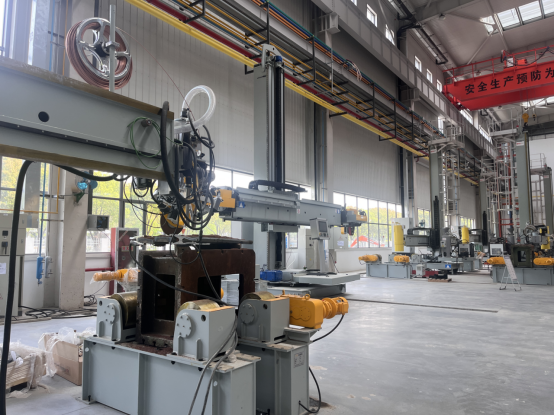In manufacturing workshops worldwide, production managers often face a common dilemma: new equipment needs installation, but already crowded spaces cannot accommodate more overhead cranes. Traditional lifting solutions require either dismantling existing equipment or investing millions in new factory construction. This spatial limitation not only impacts production efficiency but also constrains business growth. As production equipment becomes increasingly dense and automated, workspace utilization and flexible lifting capacity have become critical bottlenecks restricting production expansion and efficiency gains. While traditional overhead cranes offer strong load capacity, their fixed track structures severely limit production layout flexibility.
Column Booms: Redefining Workshop Material Handling Standards
The emergence of welding manipulator provides revolutionary solutions to these industrial challenges. These innovative systems utilize sturdy column supports and rotating boom structures, achieving 360° circular coverage from a single pivot point. Compared to traditional overhead cranes, column booms offer three core advantages: no need for overhead track installation, completely avoiding workshop structural modifications; flexible rotating arm designs that easily navigate around obstacles for precise positioning; and modular designs that support customization according to load requirements, preventing resource waste.
Technical Breakthrough: From Fixed Tracks to Free Positioning
In actual production environments, column booms demonstrate exceptional performance. At a sheet metal manufacturing facility, a 500kg capacity welding manipulator system operates efficiently. Operators effortlessly rotate the boom to transfer laser-cut sheets directly to bending machines, completing the entire process within 30 seconds. This high-efficiency operation not only enhances production efficiency but significantly reduces worker labor intensity.
The plant engineer elaborated: “The breakthrough of this system lies in its exceptional space adaptability. We completed all column installations within one week without affecting existing production. Compared to renovating roofs for new tracks, costs were reduced by over 60% and construction time shortened by 80%.” Actual measurements show that after implementing welding manipulators, material flow efficiency improved by 35%, operator waiting time for lifting operations decreased by 90%, and injury risks significantly reduced due to minimized ground transportation.

Industry Applications: Comprehensive Innovation Across Manufacturing Sectors
The application value of welding manipulators has been verified across multiple industries. In automotive manufacturing, these systems handle engine assembly and mold changeover operations, with precise positioning capabilities significantly improving assembly efficiency. Sheet metal processing enterprises use welding manipulators with vacuum lifters for efficient sheet transportation, preventing product scratches while reducing manual handling. The warehouse logistics sector utilizes these systems for material access in narrow aisle spaces, maximizing storage utilization. The equipment maintenance field also benefits, providing machine tool maintenance support without relying on workshop main cranes.
A multinational automotive parts supplier’s operations director shared their experience: “We have implemented column boom systems across multiple global factories, not only solving space limitation issues but also enabling production line flexible reconfiguration – advantages unattainable with traditional lifting equipment.” This cross-industry successful application fully demonstrates the practical value and adaptability of these systems.
Selection Guide: How to Evaluate Suitable Equipment
For companies considering equipment upgrades, evaluation should consider multiple dimensions. First, examine coverage range, selecting appropriate boom length based on work area radius. Second, focus on rotation performance – quality products should achieve 360° continuous rotation with consistent resistance ensuring smooth operation. Finally, verify safety configurations including overload protection, mechanical limits, and insulated hook options, all crucial for safe production.
Equipment installation conditions also require serious consideration. High-quality welding manipulator offer various fixing methods including base plate type and embedded type installation solutions, and even mobile solutions requiring no foundation, meeting diverse workshop requirements. These flexible options enable the equipment to adapt to various complex workshop environments.

Future Outlook: Intelligent Upgrade Development Directions
With deepening Industry 4.0 technology applications, intelligent welding manipulators are advancing to higher levels. Latest technology trends include integrated weight sensors for real-time load monitoring, RFID technology for load identification, and AGV system integration for fully automated material transportation. These technological innovations will not only enhance individual equipment performance but also promote intelligent transformation of entire material handling systems.
The development of intelligent handling equipment represents an important direction in manufacturing digital transformation. By combining traditional material handling equipment with modern information technology, enterprises can build smarter, more efficient production logistics systems. This transformation not only improves production efficiency but also provides sustainable competitive advantages for businesses.
Conclusion: The Inevitable Choice for Modern Manufacturing
Amid manufacturing transformation and upgrading, adopting advanced welding manipulators is no longer merely equipment updates but important strategic choices for enterprises to enhance space utilization and achieve flexible production. For companies struggling with workshop space and lifting efficiency, now is the perfect time to embrace technological innovation and move toward smart manufacturing. As technology continues advancing and applications deepening, these systems will undoubtedly play increasingly important roles in more industries and scenarios, providing strong support for enterprise development and operational excellence.
